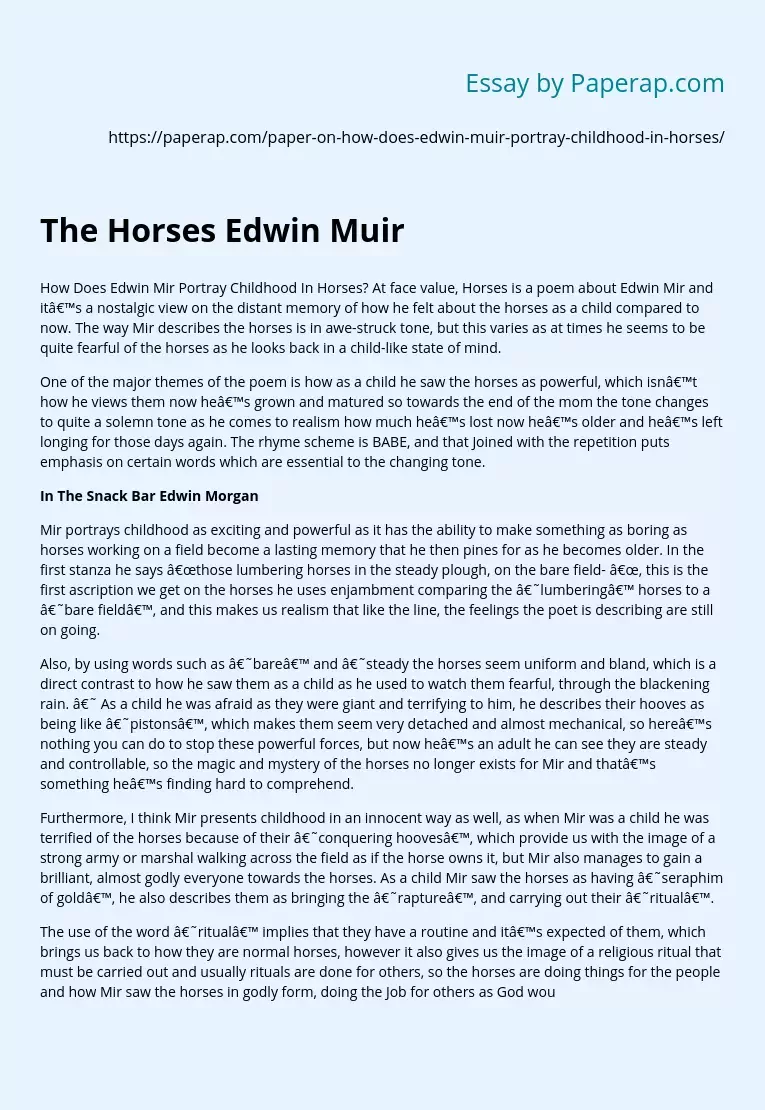How Does Edwin Mir Portray Childhood In Horses? At face value, Horses is a poem about Edwin Mir and it’s a nostalgic view on the distant memory of how he felt about the horses as a child compared to now. The way Mir describes the horses is in awe-struck tone, but this varies as at times he seems to be quite fearful of the horses as he looks back in a child-like state of mind.
One of the major themes of the poem is how as a child he saw the horses as powerful, which isn’t how he views them now he’s grown and matured so towards the end of the mom the tone changes to quite a solemn tone as he comes to realism how much he’s lost now he’s older and he’s left longing for those days again.
The rhyme scheme is BABE, and that Joined with the repetition puts emphasis on certain words which are essential to the changing tone.
In The Snack Bar Edwin Morgan
Mir portrays childhood as exciting and powerful as it has the ability to make something as boring as horses working on a field become a lasting memory that he then pines for as he becomes older. In the first stanza he says “those lumbering horses in the steady plough, on the bare field- “, this is the first ascription we get on the horses he uses enjambment comparing the ‘lumbering’ horses to a ‘bare field’, and this makes us realism that like the line, the feelings the poet is describing are still on going.
Also, by using words such as ‘bare’ and ‘steady the horses seem uniform and bland, which is a direct contrast to how he saw them as a child as he used to watch them fearful, through the blackening rain. ‘ As a child he was afraid as they were giant and terrifying to him, he describes their hooves as being like ‘pistons’, which makes them seem very detached and almost mechanical, so here’s nothing you can do to stop these powerful forces, but now he’s an adult he can see they are steady and controllable, so the magic and mystery of the horses no longer exists for Mir and that’s something he’s finding hard to comprehend.
Furthermore, I think Mir presents childhood in an innocent way as well, as when Mir was a child he was terrified of the horses because of their ‘conquering hooves’, which provide us with the image of a strong army or marshal walking across the field as if the horse owns it, but Mir also manages to gain a brilliant, almost godly everyone towards the horses. As a child Mir saw the horses as having ‘seraphim of gold’, he also describes them as bringing the ‘rapture’, and carrying out their ‘ritual’.
The use of the word ‘ritual’ implies that they have a routine and it’s expected of them, which brings us back to how they are normal horses, however it also gives us the image of a religious ritual that must be carried out and usually rituals are done for others, so the horses are doing things for the people and how Mir saw the horses in godly form, doing the Job for others as God would do.
There are many biblical references in the description of the horses from Mir as a child’s point of view, so I feel that Mir is trying to show the reader how the innocence of a child can make something as simple and plain as horses plugging a field god-like even though horses don’t feel anything like that. Mir also portrays childhood as a state of mind which one should love and cherish, as in the last stanza Mir states that he must ‘plane’ Tort Tanat Telling again.
I en use AT ten word ‘plane’ snows Tanat en must long Tort It, and the use of the mono-syllabic and direct word ‘must’ shows that he has no other choice than to ‘pine’ for the child like state of mine he no longer possesses, as it makes everything you see so much more interesting. In conclusion, I feel that Mir portrays childhood as something powerful, innocent and something we should try and cling on to for as long as we can, as it can make the ordinary things we see lasting and vivid memories which we are no longer able to do as adults.
The Horses Edwin Muir. (2019, Dec 05). Retrieved from https://paperap.com/paper-on-how-does-edwin-muir-portray-childhood-in-horses/

